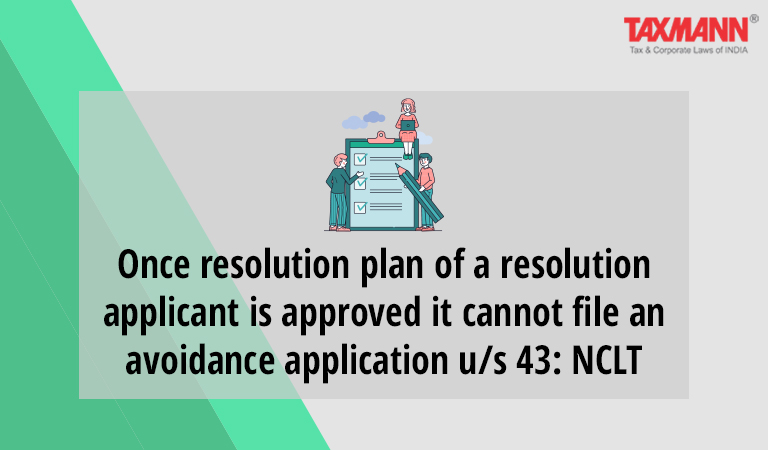Once resolution plan of a resolution applicant is approved it cannot file an avoidance application u/s 43: NCLT
- Blog|News|Insolvency and Bankruptcy Code|
- 2 Min Read
- By Taxmann
- |
- Last Updated on 25 September, 2021

Case Details: Tuf Metallurgical (P.) Ltd. v. Albus India Ltd. - [2021] 130 taxmann.com 248 (NCLT - New Delhi)
Judiciary and Counsel Details
-
- P.S.N. Prasad, Judicial Member and Narender Kumar Bhola, Technical Member
- Vaibhav Mahajan, Abhishek Anand, Kunal Godhwani and Pathik Choudhary, Advs. for the Appellant. Mohit Nandwani, and Akshat Bajpai, Advs. for the Respondent.
Facts of the Case
The Petition under section 7 of the Insolvency and Bankruptcy Code, 2016 (IBC) was allowed by the Tribunal in this instance, triggering the corporate debtor’s Corporate Insolvency Resolution Process (CIRP).
The applicants then claimed that the resolution plan presented by applicant No. 1 was unanimously approved by the Committee of Creditors (CoC) and that he was proclaimed the winning resolution applicant. The Tribunal also gave its permission, and as a result, the Resolution Professional and the CoC were relieved of their duties and obligations as of the approval date.
However, in terms of clause 12 of the Resolution Plan, a Monitoring Committee (Applicant No. 2) consisting of three members was conceptualized for supervising the implementation of the Resolution Plan by the successful Resolution Applicant. The successful resolution applicant and Monitoring Committee (applicant Nos. 1 and 2) under section 60(5), read with rule 11, of NCLT Rules, 2016 sought intervention in support of application filed by Ex-Resolution Professional under section 66 read with section 43 and to allow the applicants access to all the reports, findings and other documents submitted in connection with said application.
The applicants argued that any benefit derived from the said application would benefit the corporate debtor/Successful Resolution Applicant, and that the same could be shared with other Financial Creditors, and that as a result, the applicants have a vested interest in the prosecution and intervention of the said application, as well as a right to be heard before the case is finally decided.
However, respondent No. 1 argued that the current case was not maintainable since it sought intervention in an avoidance application that could not be evaluated until after the plan had been approved.
NCLAT Held
According to the NCLAT, after a Resolution Applicant’s Resolution plan has been accepted, the Resolution Applicant cannot submit an avoidance application under section 43 of the IBC. It is important to note that the case at hand, in which applicant No. 1 is a successful resolution applicant seeking to intervene in an Avoidance application filed by the former Resolution professional prior to the approval of the resolution plan, is untenable, and no direction prayed in the present application can be granted to the applicants.
As a result, in light of the foregoing, the current application is dismissed after careful examination of the entire issue and hearing the views of the applicants and non-applicants.
Case Review
-
- Venus Recruiters (P.) Ltd. v. Union of India [2020] 121 taxmann.com 346 (Delhi) (para 5) followed.
List of Cases Referred To
-
- State Bank of India v. Adhunik Steels Ltd. [2020] 116 taxmann.com 955 (NCLT – Cuttack) (para 1)
- Venus Recruiters (P.) Ltd. v. Union of India [2020] 121 taxmann.com 346 (Delhi) (para 2)
Disclaimer: The content/information published on the website is only for general information of the user and shall not be construed as legal advice. While the Taxmann has exercised reasonable efforts to ensure the veracity of information/content published, Taxmann shall be under no liability in any manner whatsoever for incorrect information, if any.

Taxmann Publications has a dedicated in-house Research & Editorial Team. This team consists of a team of Chartered Accountants, Company Secretaries, and Lawyers. This team works under the guidance and supervision of editor-in-chief Mr Rakesh Bhargava.
The Research and Editorial Team is responsible for developing reliable and accurate content for the readers. The team follows the six-sigma approach to achieve the benchmark of zero error in its publications and research platforms. The team ensures that the following publication guidelines are thoroughly followed while developing the content:
- The statutory material is obtained only from the authorized and reliable sources
- All the latest developments in the judicial and legislative fields are covered
- Prepare the analytical write-ups on current, controversial, and important issues to help the readers to understand the concept and its implications
- Every content published by Taxmann is complete, accurate and lucid
- All evidence-based statements are supported with proper reference to Section, Circular No., Notification No. or citations
- The golden rules of grammar, style and consistency are thoroughly followed
- Font and size that’s easy to read and remain consistent across all imprint and digital publications are applied





